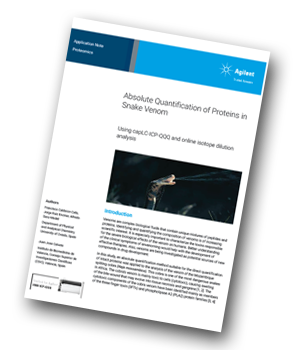Agilent Technologies has produced an application note describing the absolute quantification of snake venom proteins. Using capillary LC to separate the proteins, followed by sulfur determination using isotope dilution ICP-QQQ, accurate concentrations were obtained without protein-specific standards.
 Introduction
Introduction
Venoms are complex biological fluids that contain unique mixtures of peptides and proteins. Identifying and quantifying the composition of venoms is of increasing scientific interest. It is especially important to characterize the toxins responsible for the severe biological effects of the venom on humans. Better understanding of the clinical symptoms of envenoming would help with the development of effective therapies. Also, venoms are being investigated as potential sources of new compounds in drug development.
In this study, an absolute quantification method suitable for the direct quantification of intact proteins was applied to the analysis of the venom of the Mozambique spitting cobra (Naja mossambica). This cobra is one of the most dangerous snakes in Africa. The cobra’s venom is mainly toxic to cells (cytotoxic), causing swelling of the bite wound that may evolve into tissue necrosis and gangrene.
In this study, capLC-ICP-QQQ was used for the quantitative analysis of intact proteins, isolated, and present in simple mixtures. The method was also applied to the analysis and quantification of the major toxins comprising the venom proteome of the Mozambique spitting cobra.
Instrumentation
Capillary LC separation was performed using an Agilent 1200 Series HPLC system fitted with a BIOShellTM A400 C4, 3.4 μm, 150 mm x 0.3 mm reversed-phase column (Sigma-Aldrich, Germany) and autosampler.
Results and Discussion
Absolute protein quantification
Absolute quantification of proteins was achieved through the measurement of sulfur by capHPLC-ICP-QQQ, with postcolumn IDA. Two individual protein samples (BSA and mAb) were spiked with BOC-Met-OH IS. Quantitative ID (mass purity) results for BSA, 95 ± 5% (n=3), compared well with the sample purity data provided by the manufacturer (≥ 98 %). The ID mass purity result for Intact mAb was 77 ± 4% (n=3).
Conclusions
The capLC-ICP-QQQ method uses measurement of sulfur by IDA to enable the absolute quantification of intact proteins without the need for protein-specific standards.
Agilent ICP-QQQ instrumentation is especially suited for IDA analysis of S as it uses MS/MS to remove multiple spectral interferences from several S isotopes using an oxygen massshift method. By adding enriched 34S post-column and spiking each sample with a generic S-containing internal standard, multiple S isotopes can be measured as SO+ product ions.
The method was applied successfully to the quantification and mass purity confirmation of protein standards. If quantitative chromatographic recoveries can be assured, it is even possible to quantify nonpure protein samples using this method. The potential of the methodology for the quantification of intact proteins present in relatively complex samples was demonstrated by analysing 27 proteins in snake venom.
